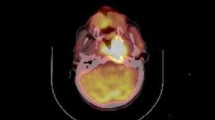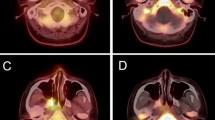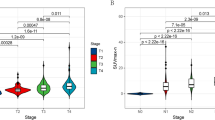Abstract
Purpose
The purpose of this study was to evaluate the prognostic value of metabolic tumor volume (MTV) and metabolic index (MI) from fluorine-18-fluorodeoxyglucose positron emission tomography/computed tomography (18F-FDG PET/CT) in patients with nasopharyngeal carcinoma (NPC).
Methods
From October 2002 to July 2004, 41 patients with NPC who underwent 18F-FDG PET-CT scan before and after radiotherapy were reviewed retrospectively. All patients received intensity-modulated radiotherapy using 6MV X-rays. We examined the association of MTV and the results of long-term follow-up of the patients.
Results
Patients having tumors with an MTV below 30 cm3 had significantly better 5-year overall survival (OS) (84.6:46.7%, P = 0.006) and disease-free survival (DFS) (73.1:40.0%, P = 0.014) than patients with an MTV of 30 cm3 or greater. And the patients with MI below 130 had significantly higher 5-year OS (88.0:43.8%, P = 0.002) and DFS (76.0:37.5%, P = 0.005) than other patients. In the Cox multivariate analysis, MI and metabolic response (MR) were predictive of DFS, and we did not find a significant relationship between standard uptake value (SUV) and OS or DFS.
Conclusions
The present study shows that tumor volume parameters, especially the combination of MTV and SUV in the “metabolic index”, are valuable for predicting long-term survival. High MI may be useful for identifying patients requiring more aggressive treatment.




Similar content being viewed by others
References
Allal AS, Slosman DO, Kebdani T et al (2004) Prediction of outcome in head-and-neck cancer patients using the standardized uptake value of 2-18F-fluoro-2-deoxy-d-glucose. Int J Radiat Oncol Biol Phys 59:1295–1300
Chan SC, Chang JT, Wang HM et al (2009) Prediction for distant failure in patients with stage M0 nasopharyngeal carcinoma: the role of standardized uptake value. Oral Oncol 45:52–58
Cheson BD, Pfistner B, Juweid ME et al (2007) Revised response criteria for malignant lymphoma. J Clin Oncol 25:579–586
Cunningham D, Allum WH, Stenning SP et al (2006) Perioperative chemotherapy versus surgery alone for resectable gastroesophageal cancer. N Engl J Med 80:11–20
Eschmann SM, Friedel G, Paulsen F et al (2006) Is standardized (18)F-FDG uptake value an outcome predictor in patients with stage III non-small cell lung cancer? Eur J Nucl Med Mol Imaging 33:263–269
Greven KM, Williams DW 3rd, McGuirt WF Sr et al (2001) Serial positron emission tomography scans following radiation therapy of patients with head and neck cancer. Head Neck 23:942–946
Grow A, Quon A, Graves EE et al (2005) Metabolic tumor volume as an independent prognostic factor in lymphoma. J Clin Oncol (ASCO Ann Meeting Proc Suppl) 23:6594
Huang SC (2000) Anatomy of SUV. Standardized uptake value. Nucl Med Biol 27:643–646
Juweid ME, Stroobants S, Hoekstra OS et al (2007) Use of positron emission tomography for response assessment of lymphoma: consensus of the Imaging Subcommittee of International Harmonization Project in Lymphoma. J Clin Oncol 25:571–578
Kao CH, Shiau YC, Shen YY et al (2002) Detection of recurrent or persistent nasopharyngeal carcinomas after radiotherapy with technetium-99m methoxyisobutylisonitrile single photon emission computed tomography and computed tomography: comparison with 18-fluoro-2-deoxyglucose positron emission tomography. Cancer 94:1981–1986
Krishna SM, James S, Balaram P (2006) Expression of VEGF as prognosticator in primary nasopharyngeal cancer and its relation to EBV status. Virus Res 115:85–90
La TH, Filion EJ, Turnbull BB et al (2009) Metabolic tumor volume predicts for recurrence and death in head-and-neck cancer. Int J Radiat Oncol Biol Phys 74:1335–1341
Lee SW, Cho KJ, Park JH et al (2005) Expressions of Ku70 and DNA-PKcs as prognostic indicators of local control in nasopharyngeal carcinoma. Int J Radiat Oncol Biol Phys 62:1451–1457
Lee P, Weerasuriya DK, Lavori PW et al (2007) Metabolic tumor burden predicts for disease progression and death in lung cancer. Int J Radiat Oncol Biol Phys 69:328–333
Lee SW, Nam SY, Im KC et al (2008) Prediction of prognosis using standardized uptake value of 2-18F-fluoro-2-deoxy-d-glucose positron emission tomography for nasopharyngeal carcinomas. Radiother Oncol 87:211–216
Lin C, Itti E, Haioun C et al (2007) Early 18F-FDG PET for prediction of prognosis in patients with diffuse large B-cell lymphoma: SUV-based assessment versus visual analysis. J Nucl Med 48:1626–1632
Lordick F, Ott K, Krause BJ et al (2007) PET to assess early metabolic response and to guide treatment of adenocarcinoma of the oesophagogastric junction: the MUNICON phase II trial. Lancet Oncol 8:797–805
Nahmias C, Hanna WT, Wahl LM et al (2007) Time course of early response to chemotherapy in non-small cell lung cancer patients with 18F-FDG PET/CT. J Nucl Med 48:744–751
Nakao K, Mochiki M, Nibu K et al (2006) Analysis of prognostic factors of nasopharyngeal carcinoma: impact of in situ hybridization for Epstein–Barr virus encoded small RNA 1. Otolaryngol Head Neck Surg 134:639–645
Roedl JB, Halpern EF, Colen RR et al (2009) Metabolic tumor width parameters as determined on PET/CT predict disease-free survival and treatment response in squamous cell carcinoma of the esophagus. Mol Imaging Biol 11:54–60
Sasaki R, Komaki R, Macapinlac H et al (2005) [18F]Fluorodeoxy-glucose uptake by positron emission tomography predicts outcome of non-small-cell lung cancer. J Clin Oncol 23:1136–1143
Schwarz JK, Siegel BA, Dehdashti F et al (2008) Tumor response and survival predicted by post-therapy FDG-PET/CT in anal cancer. Int J Radiat Oncol Biol Phys 71:180–186
Song SY, Kim JH, Ryu JS et al (2005) FDG-PET in the prediction of pathologic response after neoadjuvant chemoradiotherapy in locally advanced, resectable esophageal cancer. Int J Radiat Oncol Biol Phys 63:1053–1059
Spiro SG, Buscombe J, Cook G et al (2008) Ensuring the right PET scan for the right patient. Lung Cancer 59:48–56
Swisher SG, Maish M, Erasmus JJ et al (2004) Utility of PET, CT, and EUS to identify pathologic responders in esophageal cancer. Ann Thorac Surg 78:1152–1160
Tsai MH, Shiau YC, Kao CH et al (2002) Detection of recurrent nasopharyngeal carcinomas with positron emission tomography using 18-fluoro-2-deoxyglucose in patients with indeterminate magnetic resonance imaging findings after radiotherapy. J Cancer Res Clin Oncol 128:279–282
van Rens MT, de la Riviere AB, Elbers HR et al (2000) Prognostic assessment of 2,361 patients who underwent pulmonary resection for non-small cell lung cancer, stage I, II, and IIIA. Chest 117:374–379
van Tinteren H, Hoekstra OS, Smit EF et al (2002) Effectiveness of positron emission tomography in the preoperative assessment of patients with suspected non-small-cell lung cancer: the PLUS multicentre randomised trial. Lancet 359:1388–1393
Wang LF, Chai CY, Kuo WR et al (2006) Correlation between proliferating cell nuclear antigen and p53 protein expression and 5-year survival rate in nasopharyngeal carcinoma. Am J Otolaryngol 27:101–105
Wieder HA, Beer AJ, Lordick F et al (2005) Comparison of changes in tumor metabolic activity and tumor size during chemotherapy of adenocarcinomas of the esophagogastric junction. J Nucl Med 46:2029–2034
Wong RJ, Lin DT, Schoder H et al (2002) Diagnostic and prognostic value of [(18)F]fluorodeoxyglucose positron emission tomography for recurrent head and neck squamous cell carcinoma. J Clin Oncol 20:4199–4208
Xu X, Yu J, Sun X et al (2008) The prognostic value of 18F-fluorodeoxyglucose uptake by using serial positron emission tomography and computed tomography in patients with stage III non-small cell lung cancer. Am J Clin Oncol 31:470–475
Yeh SA, Tang Y, Lui CC et al (2005) Treatment outcomes and late complications of 849 patients with nasopharyngeal carcinoma treated with radiotherapy alone. Int J Radiat Oncol Biol Phys 62:672–679
Acknowledgments
The authors thank Dr. Huiqing Li and Jinsong Zheng for their assistance with this paper.
Author information
Authors and Affiliations
Corresponding author
Rights and permissions
About this article
Cite this article
Xie, P., Yue, JB., Zhao, Hx. et al. Prognostic value of 18F-FDG PET-CT metabolic index for nasopharyngeal carcinoma. J Cancer Res Clin Oncol 136, 883–889 (2010). https://doi.org/10.1007/s00432-009-0729-7
Received:
Accepted:
Published:
Issue Date:
DOI: https://doi.org/10.1007/s00432-009-0729-7




